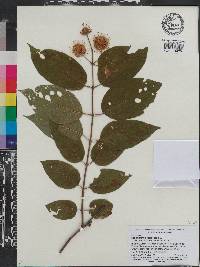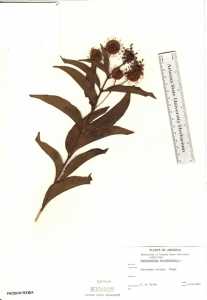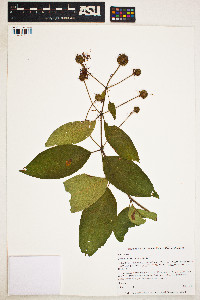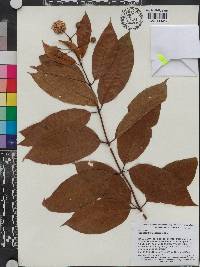|
|
|
|
Family: Rubiaceae
common buttonbush
[Cephalanthus occidentalis var. californicus Benth., moreCephalanthus occidentalis var. pubescens Raf.] |
Plant: shrub or tree; 2-7(-10) m high, the trunks to 50 cm in diameter Leaves: 2-3 per node, 7-12 cm long, glabrous or the dorsal veins and margins minutely scabrous; blades narrowly to broadly elliptic or ovate, narrowed to short petioles, more or less attenuate at apices; stipules very small, scarious, triangular or lunate, entire or fimbriate INFLORESCENCE: heads 3-3.5 cm in diameter, solitary or cymosely clustered at ends and upper nodes of branches; peduncles 2.5-9 cm long Flowers: calyx densely pubescent within, shallowly and somewhat irregularly lobed; corolla 8 mm long, white or yellowish, more or less pubescent within, the tube slender, longer than throat and ovate obtuse lobes; anthers included; styles much exserted (to 4 mm) Fruit: dry and hard, splitting from the base at maturity into 2-4 1-seeded achene-like portions, turbinate, irregularly compressed, falling when ripe, the heads 2 cm in diameter Misc: Near streams, washes, and desert lakes; rocky creek beds REFERENCES: Dempster, Lauramay T. 1995. Rubiaceae. J. Ariz. - Nev. Sci. 29(l): 29. Shrub or small tree 1 - 5 m tall Leaves: opposite or occasionally whorled, stalked, 8 - 15 cm long, about half as wide, egg-shaped to elliptic to lance-shaped with a rounded to tapering base and pointed tip, sometimes somewhat hairy beneath. Stipules 2 - 3 mm long, triangular, with gland-toothed margins. Inflorescence: a white, spherical head of many crowded flowers, long stalked, about 3 cm wide, growing at the end of a stem or in an upper leaf axil. Flowers: white, 5 mm - 1 cm long, tubular, four-lobed, with a long, thread-like style. Stamens four. Fruit: a two-seeded nutlet, in spherical masses (2 - 2.5 cm wide), brown, to 5 mm long, reverse cone-shaped, angular, persisting in winter. Form: rounded, with one or multiple trunks. Similar species: No information at this time. Flowering: late June to August Habitat and ecology: Locally frequent in variety of wet areas, including marshes, bogs, and wooded floodplains. Occurence in the Chicago region: native Notes: Toxic if eaten. Etymology: Cephalanthus comes from the Greek words kephale, meaning head, and anthos, meaning flower (flowering head)." Occidentalis means "of or from the West." Author: The Morton Arboretum Shrub 1-3 m, or even a small tree; lvs opposite or occasionally in whorls of 3, ovate-oblong or lance-oblong, 8-15 cm; stipules deltoid, 2-3 mm, glandular- dentate; heads 3 cm thick, on elongate peduncles terminating the stems or from the upper axils, the fls intermingled with filiform-clavate bractlets; cor white, 5-8 mm; fr obconic, angular, 5 mm; 2n=44. Swamps and streamsides; N.S., N.B. and Que. to Minn., s. to Mex. and W.I. June-Aug. Most of our plants are glabrous or inconspicuously hairy, and represent var. occidentalis. The chiefly southern var. pubescens Raf., with the twigs and lower lf-surfaces evidently soft-hairy, extends n. to Va., Ind. and Mo. Gleason, Henry A. & Cronquist, Arthur J. 1991. Manual of vascular plants of northeastern United States and adjacent Canada. lxxv + 910 pp. ©The New York Botanical Garden. All rights reserved. Used by permission. Demptster 1995, Wiggins 1964 Common Name: common buttonbush Duration: Perennial Nativity: Native Lifeform: Tree Wetland Status: OBL General: Shrub or small tree 2-7 m tall with opposite leaves, the trunks to 50 cm in diameter. Leaves: Opposite, 2-3 per node, each 7-12 cm long, glabrous or with minutely scabrous margins and dorsal veins, blades narrowly elliptic or ovate, narrowed to short petioles, attenuate at apices, stipules very small, scarious, triangular to lunate, entire. Flowers: Spherical pedunculate head 3-35 cm in diameter, solitary or cymosely clustered at ends and upper nodes of branches, peduncles 2.5-9 cm long; flower with calyx densely pubescent, shallowly and somewhat irregularly lobed, corolla 8 mm long, white or yellowish, more or less pubescent within, tube slender, longer than throat and ovate lobes, anthers included but styles much exserted to 4 mm. Fruits: Turbinate achene, irregularly compressed, falling when ripe. Ecology: Found along the margins of streams, often in canyons in rocky soils to marshy land from 1,500-4,500 ft (457-1372 m); flowers June-September. Notes: Ours is var. californicus which is distinguished by the narrower, generally smaller and less abruptly petiolate leaves often on shorter petioles. Ethnobotany: Used for eye trouble and as a medicine for dysentery. Etymology: Cephalanthus is from Greek kephale, head and anthos, flower, while occidentalis means of the west. Synonyms: Cephalanthus occidentalis var. californicus, C. occidentails var. pubescens Editor: SBuckley, 2010 |
|
|
|


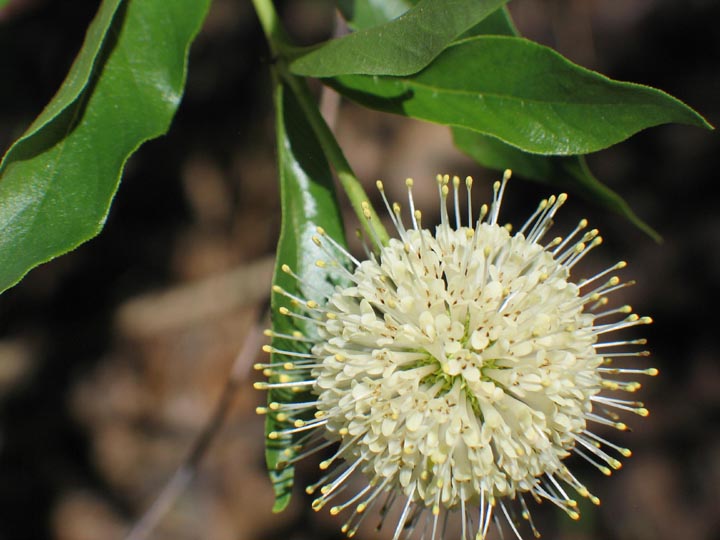
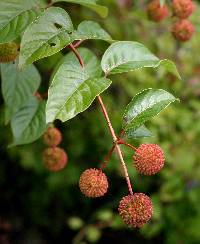
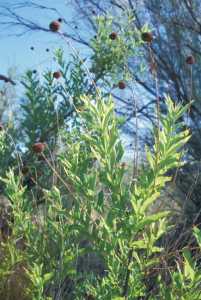
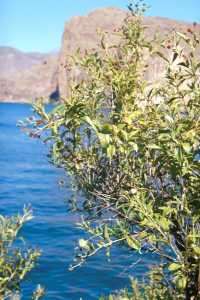
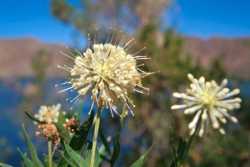
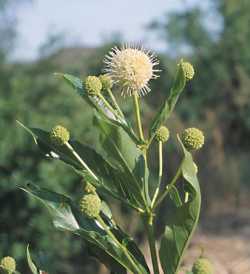
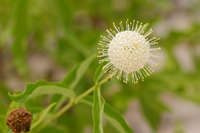
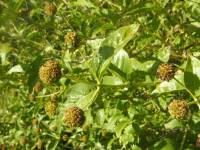
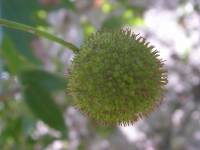
_tn.jpg)

